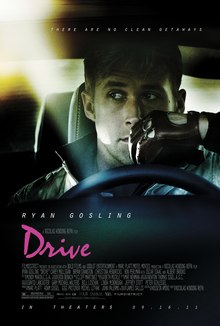The "Drive" Effect
In 2011, Nicolas Winding Refn brought to theaters a
deliberately paced, hyper-graphic drama called “Drive,” which starred Ryan
Gosling as an unnamed stunt driver who becomes smitten with neighbor-girl
Irene, played by Carey Mulligan whose boyfriend falls into with the wrong crowd,
led by Albert Brooks and Ron Perlman. Gosling’s Driver, in an effort to protect
Irene, goes after the gangsters and after a number of incredibly gruesome
deaths, Gosling and Brooks square off in the film’s final scene.
Almost immediately, the film became a critical darling,
scoring a 93 percent on RottenTomatoes.com and was picked as the best film of
2011 by Rolling Stone’s Peter Travers. Gosling’s performance was also
universally praised and the fact that he did not get nominated for an Academy
Award was considered one of the biggest snubs of award season.
While the film certainly helped legitimize both Refn, who
had previously been best-known for 2008’s “Bronson” starring a pre-“Inception”
Tom Hardy, and Gosling, it ultimately seems to have done something far more
noteworthy: it has redefined a genre.
Prior to “Drive,” violent crime dramas were generally in the
vein of Martin Scorsese or Michael Mann: big, fast, and crisp. Movies like
Scorsese’s “The Departed” or Mann’s “Heat” featured sprawling landscapes and plots
that were driven by the action. In a post-“Drive” universe, though, plot becomes
the priority with the violence accentuating it and when those salt crystals of
violence do occur, the scenes are incredibly realistic and sometimes a little
disturbing.
Following Refn’s lead, several other films have been
released recently that are also deliberately paced and hyper-violent, most
notably Rian Johnson’s “Looper” and the recently-released “Killing Them
Softly,” directed by Andrew Dominik and starring Brad Pitt.
Both films have received critical acclaim, coming in at 94
and 78 percent respectively on RottenTomatoes.com. Both are deliberately paced
and feature occasionally graphic violence. While “Looper” may be a bit more
ambitious than the other two films, both it and “Killing Them Softly” cater to
the same crowd that proclaimed “Drive” to be the best film of 2011 and that
Andrew Dominik is involved in this style of filmmaking is not surprising, as he
has already been part of a film revolution.
Back in 2007, Dominik, along with Paul Thomas Anderson and
The Coen Brothers, revamped what Westerns could be and how those films could be
presented. Gone were the days of Sergio Leone and Clint Eastwood, where an
unknown stranger comes in, shoots up the bad guys, and then rides off into the
sunset.
In 2007’s idea of a Western, the line between hero and
villain was not so clear. In fact, it was downright blurry. On one hand, Daniel
Plainview is the idea of the American Dream, growing from a humble oil man to a
full-blown tycoon in Anderson’s “There Will Be Blood.” On the other hand, the
methods that Plainview uses to achieve his goal are sometimes downright
villainous.
Characters in Joel and Ethan Coen’s “No Country for Old Men”
were equally complex (or downright terrifying in the case of Javier Bardem’s
Anton Chigurh) and Dominik’s “The Assassination of Jesse James by the CowardRobert Ford.” None of these films included a “Man with No Name” who rode in,
liberated the town, and left. Instead, these movies featured complex, dark,
tortured characters where the line between right and wrong was never clear and
rarely straight.
Was it right for Llewelyn Moss to keep a bag of money that
he found after a shootout? Probably not. Was it understandable, though, when
one considers the living conditions that he faced? Absolutely.
It is incredibly telling that this first wave of genre
re-invention came about in a time in America when the economic collapse of the
late Aughts was just beginning. Things for many Americans was starting to look
bleak and who couldn’t relate to Llewellyn stealing that bag of money or the
plight of the James Gang, who were just looking to pay the bills?
Similarly, the past year and a half has featured great
turmoil in the country. Unemployment remains high as the economy slowly pulls
itself out of the hole that was first dug half a decade ago. It should come as
no surprise that many Americans have a much bleaker outlook, an outlook that
lends itself perfectly to the themes of these movies and the darker, more
complex characters that have been created. As Brad Pitt’s character in “Killing
Them Softly,” proclaims, “America isn’t a country; it’s a business. So pay me.”
In this climate, those are sentiments that millions can agree with.
Make no mistake about it, films such as “Drive” or “There
Will be Blood” will never completely replace faster-paced, action oriented
films and one needs to look no farther than this year. “Argo” is widely viewed
as an early frontrunner for Best Picture this while and while the film is admittedly
well-done, it is made in the classic style. It is big; it is loud; and the
movie, especially the third act, unfolds at fairly rapid pace.
Deliberately
paced, hyper-violent movies will never be the norm. However, “Drive” proved
that Americans would still pay attention and, not surprisingly, people noticed.
--Tony Fioriglio
 RSS
RSS


0 Comments:
Post a Comment
Subscribe to Post Comments [Atom]
<< Home